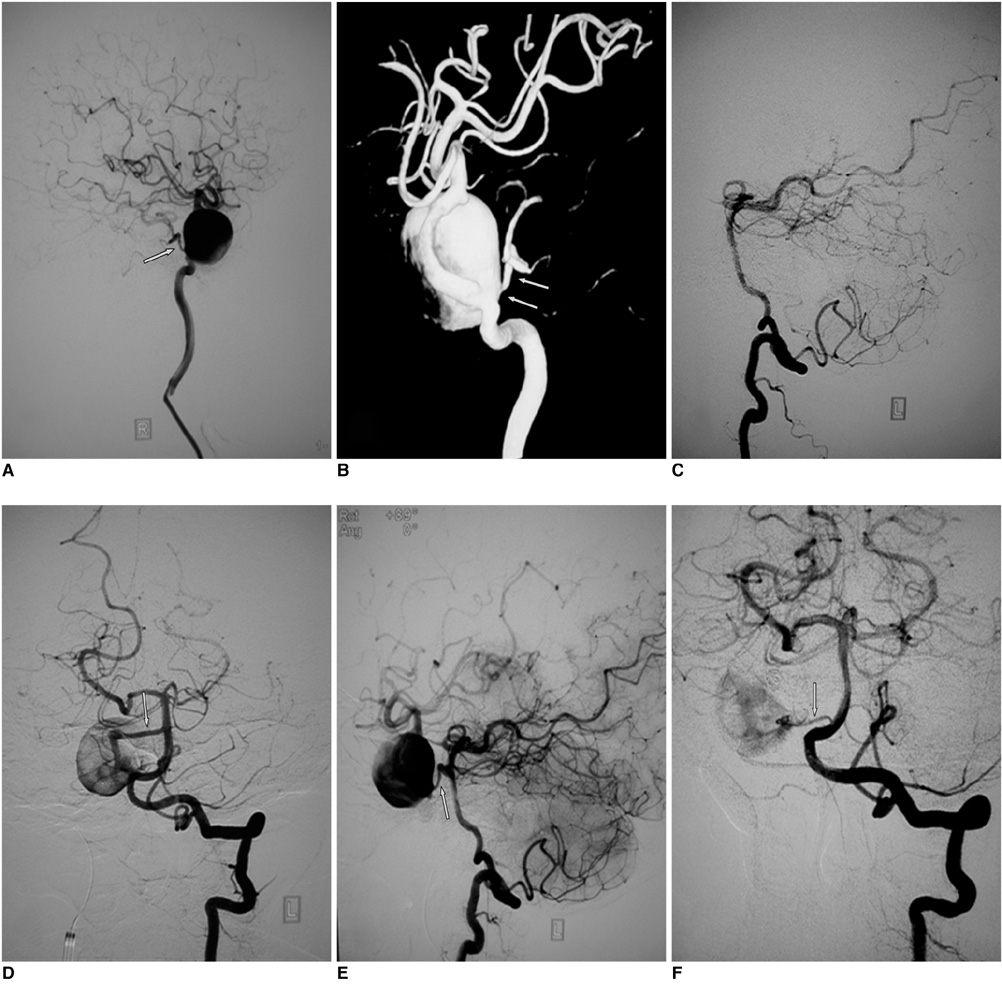Korean J Radiol.
2009 Oct;10(5):519-522. 10.3348/kjr.2009.10.5.519.
Giant Cavernous Aneurysm Associated with a Persistent Trigeminal Artery and Persistent Otic Artery
- Affiliations
-
- 1Department of Radiology, West China Hospital, Sichuan University, Chengdu, Sichuan 610041, People's Republic of China.
- 2Department of Neurosurgery, West China Hospital, Sichuan University, Chengdu, Sichuan 610041, People's Republic of China. xiaodong_1962@163.com
- KMID: 1093969
- DOI: http://doi.org/10.3348/kjr.2009.10.5.519
Abstract
- Primitive trigeminal artery (PTA) and primitive otic artery (POA) is a very rare entity in adult life. We present a case of PTA and POA associated with a giant unruptured cavernous aneurysm in a 54-year-old woman. The PTA and the POA arose from the sac of the aneurysm directly, which greatly complicated endovascular therapy management.
MeSH Terms
Figure
Reference
-
1. Yilmaz E, Ilgit E, Taner D. Primitive persistent carotid-basilar and carotid-vertebral anastomoses: a report of seven cases and a review of the literature. Clin Anat. 1995. 8:36–43.2. Caldemeyer KS, Carrico JB, Mathews VP. The radiology and embryology of anomalous arteries of the head and neck. AJR Am J Roentgenol. 1998. 170:197–203.3. Ahmad I, Tominaga T, Suzuki M, Ogawa A, Yoshimoto T. Primitive trigeminal artery associated with cavernous aneurysm: case report. Surg Neurol. 1994. 41:75–79.4. Lie AA. Congenital anomalies of the carotid arteries. 1968. Amsterdam: Excerpta Medica Foundation;70–75.5. Anderson RA, Sondheimer FK. Rare carotid-vertebrobasilar anastomoses with notes on the differentiation between proatlantal and hypoglossal arteries. Neuroradiology. 1976. 11:113–118.6. Nonaka Y, Nakatani K, Tanigawara T, Hattori T, Ohkuma A, Kaku Y, et al. A case of a persistent primitive proatlantal intersegmental artery with a ruptured basilar bifurcation aneurysm. No Shinkei Geka. 2001. 29:775–779.7. Karasawa J, Terano M, Nishikawa M, Kyoi K, Kikuchi H. Case of persistent bilateral carotid-basilar anastomoses (primitive otic artery and primitive trigeminal artery) with multiple vascular anomalies. No To Shinkei. 1972. 24:91–98. [Japanese].8. Matsushita A, Yanaka K, Hyodo A, Nose T. Persistent primitive otic artery with IC-cavernous aneurysm. J Clin Neurosci. 2003. 10:113–115.9. Agnoli AL. Vascular anomalies and subarachnoid hemorrhage associated with persisting embryonic vessels. Acta Neurochir (Wien). 1982. 60:183–199.10. Cloft HJ, Razack N, Kallmes DF. Prevalence of cerebral aneurysms in patients with persistent primitive trigeminal artery. J Neurosurg. 1999. 90:865–867.
- Full Text Links
- Actions
-
Cited
- CITED
-
- Close
- Share
- Similar articles
-
- RE: Giant Cavernous Aneurysm Associated with a Persistent Trigeminal Artery and Persistent Otic Artery
- Persistent Trigeminal Artery with a Cerebellar Branch and Trigeminal-Cavernous Fistula from Ruptured Aneurysm: Transarterial Coil Embolization
- A case of primitive persistent hypoglossal artery
- Persistent Primitive Trigeminal Artery Aneurysm: A Case Report
- Persistent Trigeminal Artery Aneurysm Treated with Guglielmi Detachable Coils


